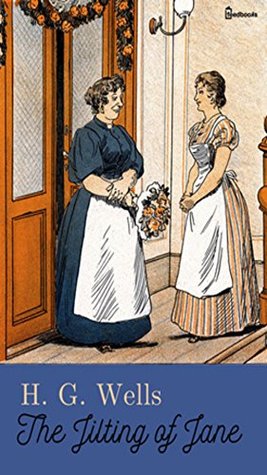“The Jilting of Jane” is a short story by the English author H. G. Wells (1866–1946), first published in about 1894 and reprinted in The Plattner Stories and OthersCollection of 17 short stories by H. G. Wells, first published in 1897. (1897) and The Country of the Blind and Other StoriesCollection of 33 short stories by H. G. Wells, first published in 1911. (1911).[1] It deals with an episode in the romantic life of a young maidservant who is engaged to be married.
Synopsis
Jane is a maid in the household of George and his wife Euphemia, who have noticed that she is not her normal cheery self, and seems to be brooding about something. She has been engaged for three years to a young man called William Piddinquirk, whom she met at an open-air church service. When they met, William was employed as second porter at Maynard’s the drapers, at a salary of eighteen shillings a week.
William at first appears to George to be a “deserving young man” although rather shabbily dressed, but Euphemia does not take to him when they meet. Soon William is promoted to become head porter at Maynard’s, at an increased salary of twenty-three shillings a week, and begins to smarten up his appearance with the addition of a silk hat and yellow gloves.
Some time later Jane tells Euphemia that William is going to be allowed to serve customers in the shop, but rather than being pleased at his further promotion she appears to be rather wistful. The following Sunday, Euphemia finds Jane in floods of tears, saying that William is being “led away” by another woman. On the following two Sundays Jane asks for permission to go out for a walk with William, but eventually she admits that her purpose was to follow William and his new love and confront them by revealing her engagement. William’s new love is unimpressed, so Jane tells her that she will suffer for what she was done.
One day Jane asks for permission to attend a wedding the following day. Euphamenia instinctively knows whose wedding that will be, but Jane is insistent that she just wants to see the last of William.
About twenty minutes after Jane set off for the wedding, Euphemia discovers that she has taken all the boots and shoes in the house with her in a bag.[a]There is a long-standing connection between shoes and fertility, perhaps exemplified by the nursery rhyme, “There was an Old Woman Who Lived in a ShoeEnglish nursery rhyme about a woman with many children.“, and the custom of casting a shoe after a bride as she leaves for her honeymoon,[2] or attaching shoes to the departing couple’s car.[3] Returning later with the bag, seemingly with all the boots still present, she tells of the “extremely respectable” ceremony, at the end of which the bride and groom emerged from the church down a red carpet to their carriage. Rice was thrown at the newly married couple, and someone threw a slipper, at which point Jane threw a boot, meaning to hit the bride but instead striking William and giving him a black eye, at which all the little boys cheered.
Jane did not have the heart to throw any more boots, and ends resignedly by saying that she no longer cares, that William will discover his mistake in due course. She concludes that she had been too stuck up, and “ought not to have looked so high”. But as George observes, Jane is still young, and “something passed the other day with the butcher-boy”. He ends the story by further observing that “We all have our sorrows, but I do not believe very much in the existence of sorrows that never heal.”
Commentary
Wells considered “The Jilting of Jane” to be among the best of his early fiction,[1] as evidenced by its inclusion in The Country of the Blind and Other StoriesCollection of 33 short stories by H. G. Wells, first published in 1911. (1911), which in his own words contains a collection of “all the short stories by me that I care for anyone to read again”.[4]
Euphemia is “usually thought to be a portrait of Jane [Catherine] Wells,[b]Wells’s second wife, also known as Amy. though the figure may have some traits of Isabel [Wells’s cousin and first wife] as well.”[5][c]Wells was married twice: to Isabel Mary Wells from 1891 until their divorce in 1894, and to Amy Catherine Robbins – later known as Jane – until her death in 1927.[6]
See also
- H. G. Wells bibliographyList of publications written by H. G. Wells during the more than fifty years of his literary career.
Notes
| a | There is a long-standing connection between shoes and fertility, perhaps exemplified by the nursery rhyme, “There was an Old Woman Who Lived in a ShoeEnglish nursery rhyme about a woman with many children.“, and the custom of casting a shoe after a bride as she leaves for her honeymoon,[2] or attaching shoes to the departing couple’s car.[3] |
|---|---|
| b | Wells’s second wife, also known as Amy. |
| c | Wells was married twice: to Isabel Mary Wells from 1891 until their divorce in 1894, and to Amy Catherine Robbins – later known as Jane – until her death in 1927.[6] |
References
Bibliography
External links
- Full text of “The Jilting of Jane” at Project Gutenberg

